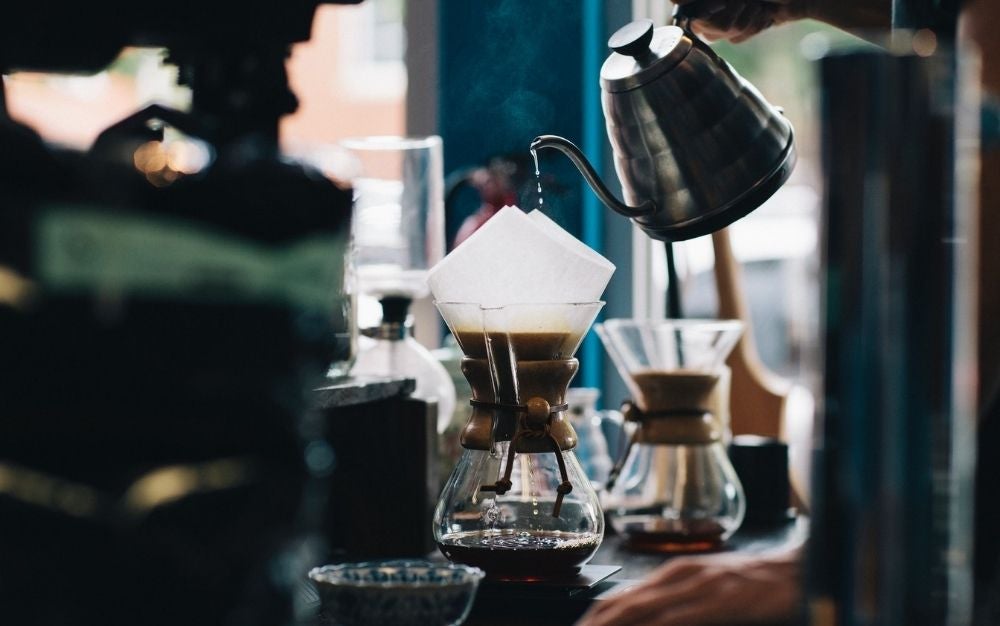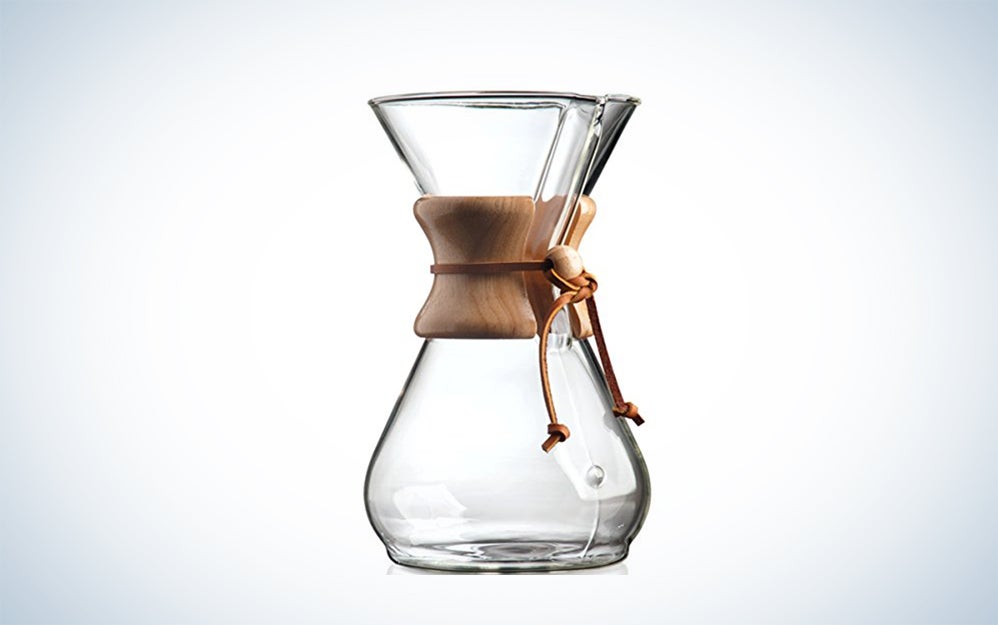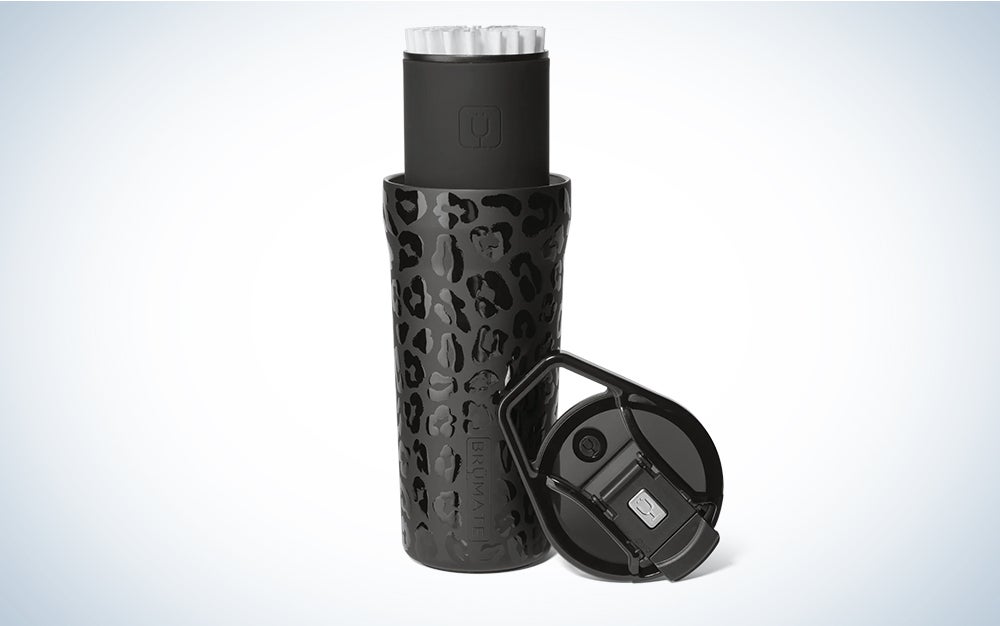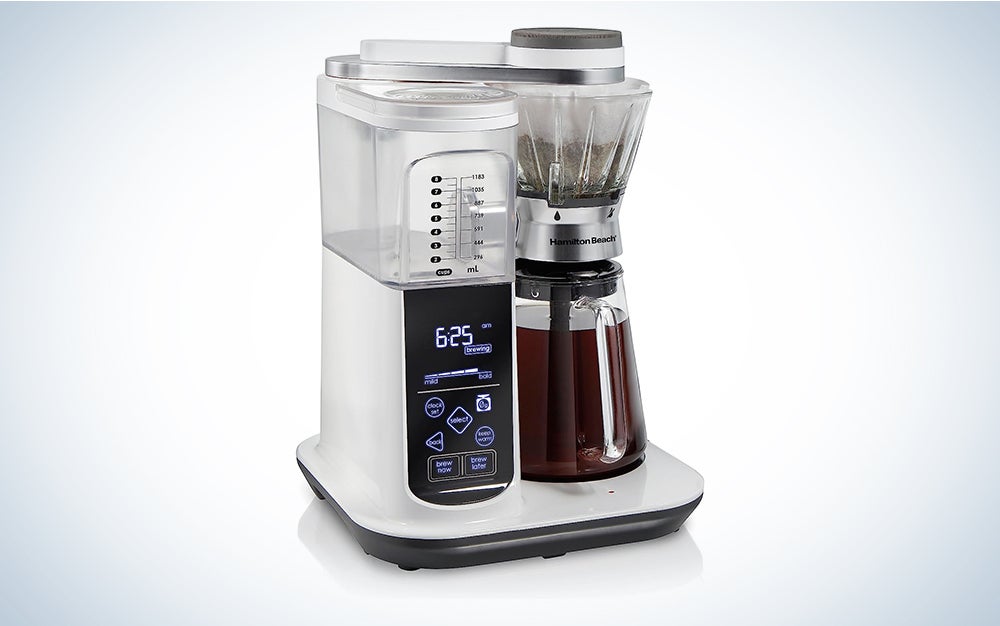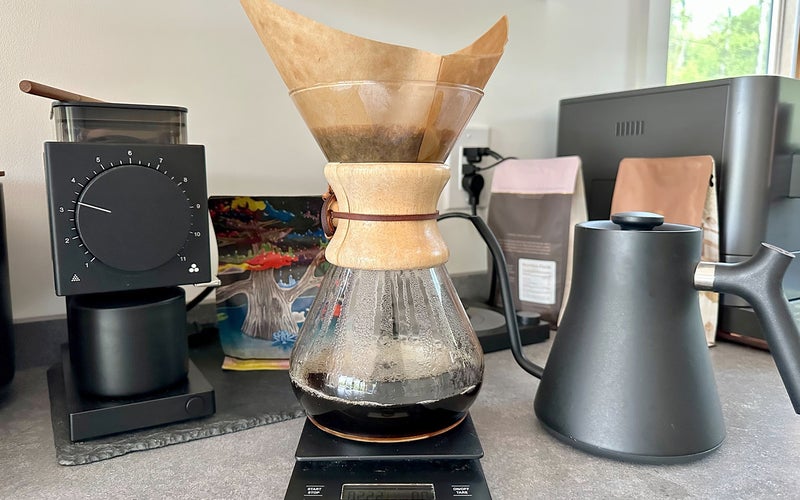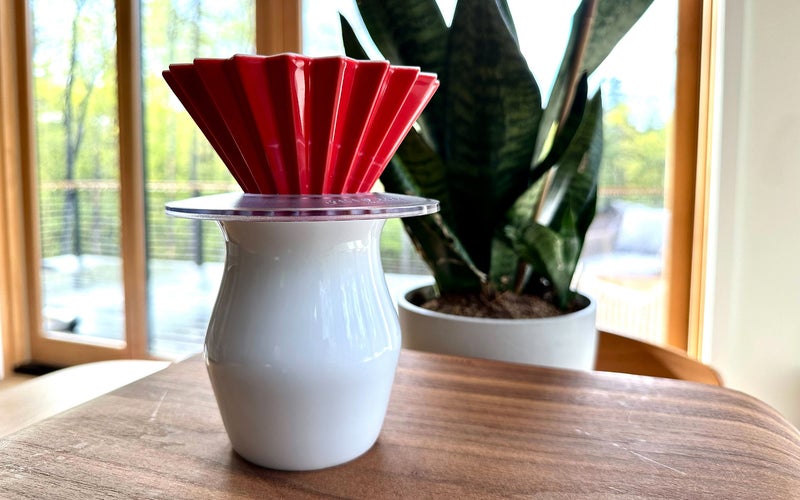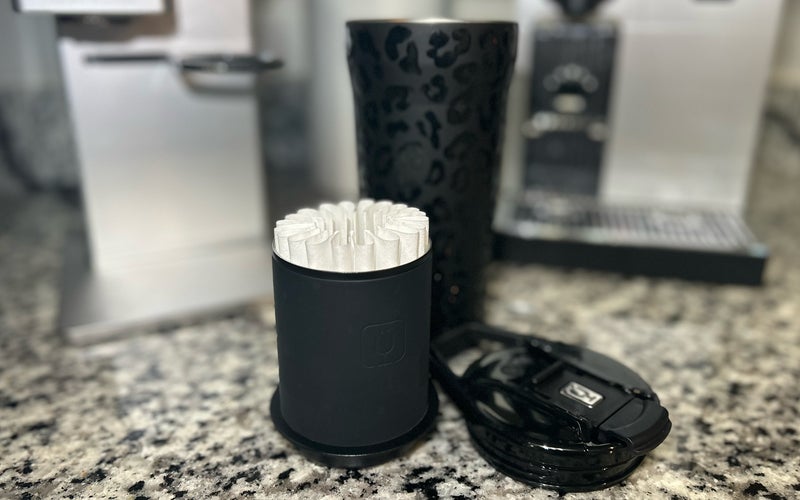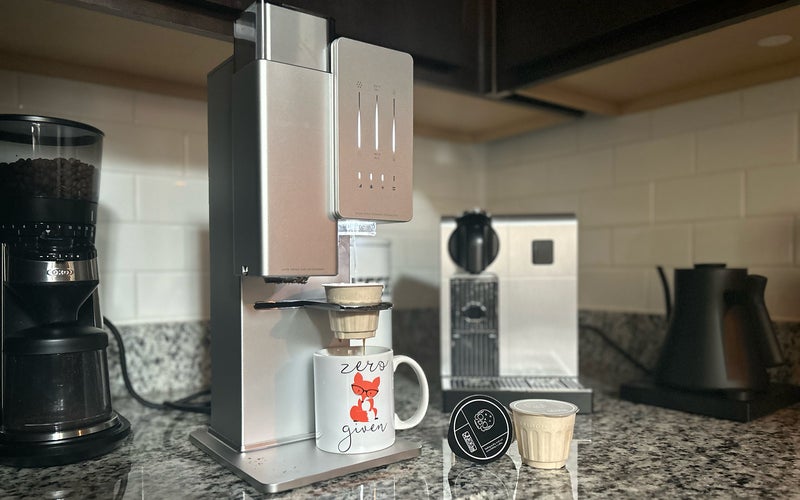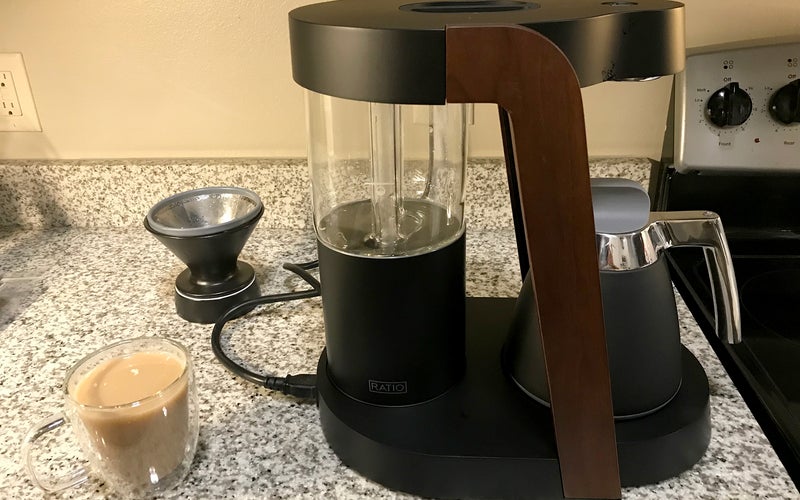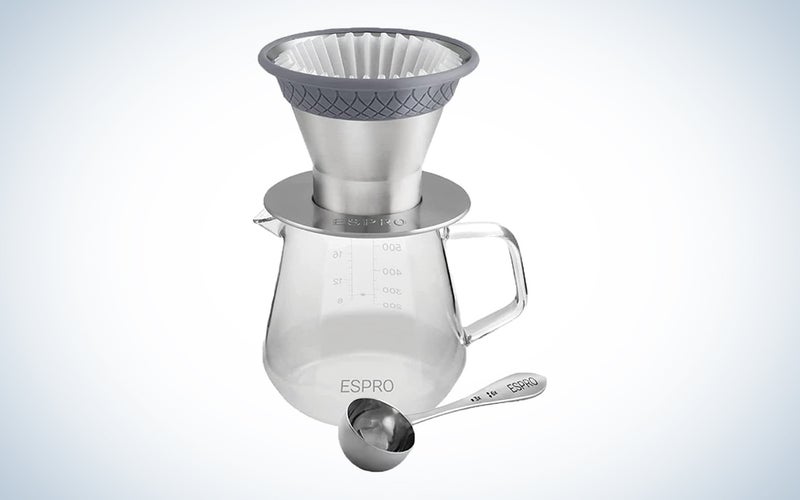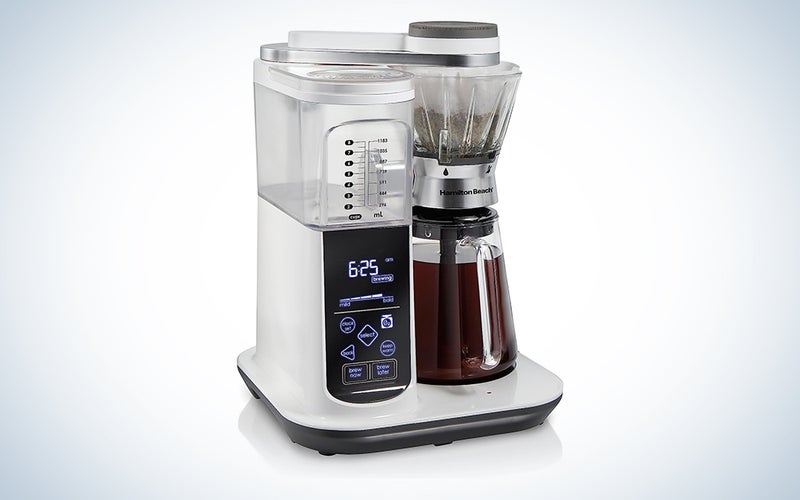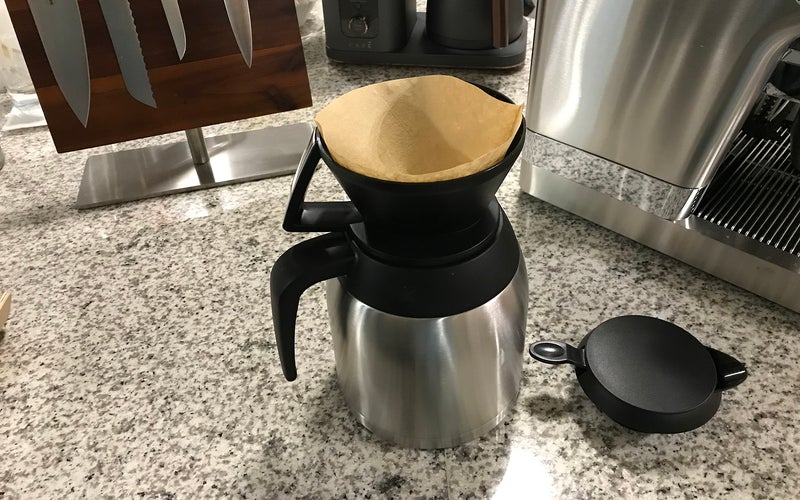We may earn revenue from the products available on this page and participate in affiliate programs. Learn more ›
If you’re a coffee lover, you know that drip coffee makers can make the brewing process quick and convenient, but nothing compares to the rich, better-tasting cup of Joe from a pour-over machine. Circularly pouring water over your coffee, deliberating drenching every facet of freshly ground beans, is a rewarding ritual. For those unfamiliar with the pour-over method, it can be confusing to figure out what type of coffee maker works best or even to know what to look for and expect when shopping for one. That’s why we’ve spoken with experts and done extensive extractions ourselves to come up with this list of the best pour-over coffee makers.
- Best overall: Chemex Pour-Over Glass Coffee Maker – Classic Series
- Best sculptural: Origami Pour-Over Coffee Dripper
- Best travel: BruMate Pour-Over Kit
- Best splurge: xBloom
- Best simplified pour-over: Ratio Eight Thermal Set
- Best pour-over kit: ESPRO BLOOM Pour-Over Kit
- Best automatic: Hamilton Beach Craft Auto Coffee Maker with Manual Pour Over
- Best with thermal carafe: Melitta Pour-Over Coffee Brewer & Stainless Steel Carafe Set
How we chose the best pour-over coffee makers
As a freelance journalist for over 10 years, I’ve reviewed home and tech products for publications including Forbes, CNN Underscored, NBC News Select, Popular Mechanics, Architectural Digest, Tom’s Guide, The Daily Beast, USA Today’s Reviewed, TechRadar, Better Homes & Gardens, and Bob Vila. I brought this experience to the task of narrowing down the pour-over coffee maker options based on various factors—and also interviewed several coffee experts for suggestions and tips on making the best cup. Based on factors listed at the end of this roundup, along with our personal love of coffee accouterments, and recommendations from colleagues, these are the best pour-over coffee makers.
The best pour-over coffee maker: Reviews & Recommendations
Pour-oven coffee makers can be compact but might take up more space than you expected if you brew for more than yourself. Greg Dawson, director of coffee at Bellwether Coffee, tells us that pour-over methods are best for 1-2 cups at a time. “Most pour-overs won’t make more than this quantity anyway, and most water kettles won’t hold enough water to brew larger quantities in one go.”
And there’s a reason why many pour-overs only make small quantities. “The greatest strength of pour-over coffee is the quality and freshness of making a single perfect cup at a time and enjoying it at its peak,” Dawson explains. “Making more coffee than you can drink at once can cause the remaining coffee to fade before you can drink it, ultimately defeating the purpose of the work you put in to make it.” So, he recommends that the primary thing you consider is the amount of coffee you consume to determine the pour-over system from our list that best fits your needs.
Best overall: Chemex Pour-Over Glass Coffee Maker – Classic Series
Billy Cadden
Why it made the cut: This elegant coffeemaker uses borosilicate glass that doesn’t absorb odors.
Specs
- Material: glass
- Dimensions: 9.6” x 6.4” x 1.3”
- Weight: 1.3 pounds
- Brewing capacity: 40 ounces (8 cups)
Pros
- Generous 8-cup capacity
- Borosilicate glass does not absorb odors
- Can be refrigerated and reheated
- Other sizes available
Cons
- Glass is breakable
The design of the Chemex Pour-Over Glass Coffee Maker is so impressive that it’s in several prestigious museums. But the hourglass shape of the borosilicate glass with lathed wooden collar is as functional as it is beautiful. Chemex makes a variety of pour-over coffee makers in six sizes ranging from 3 cups to 13 cups. The company also makes different types of pour-over coffee makers. We chose the Classic design in the 8-cup (40-ounce) version as the middle ground. As the best glass pour-over, the Chemex is strong enough to resist breaking easily (although it is, indeed, breakable), and it also resists odors and chemical residue, so the coffee always tastes pure. The pour spout makes it easy to pour without making a mess. Also, the rawhide handles are available in various colors, including original, green, black, blue, pink, and red—and the rawhide drawstrings come in several colors as well. For the best results, Chemex recommends using the company’s bonded filters.
Best sculptural: Origami Pour-Over Coffee Dripper
Billy Cadden
Why it made the cut: The bright colors of our best ceramic pour-over coffee dripper add interest to any countertop.
Specs
- Material: Ceramic
- Dimensions: 5 ½” x 3 ½”
- Weight: 7 oz.
- Brewing capacity: 4 cups
Pros
- Numerous color choices
- Ceramic
- Heat retention
Cons
- Requires a separate container
The Origami Pour-Over Coffee Dripper is made of dishwasher-safe ceramic, which tends to retain heat. It’s available in two sizes (small and medium) and several bright colors, including orange, yellow, white, matte green, turquoise, purple, and matte gray. Remember, it’s a pour-over coffee dripper, so you must use a separate container to catch the coffee, which is filtered through Origami Coffee Paper Filters, Kalita Wave filters, or V60 paper filters placed in the folded pottery—designed for maximum airflow and drainage. This could even be our best budget pick, were it not for the $17.99 OXO Single-Serve Pour-Over Coffee Maker.
Best travel: BrüMate Pour-Over Kit
Tony Ware
Why it made the cut: You can pour right into your travel mug with this leak-proof brewer that fits in your cup holder.
Specs
- Material: Silicone sleeve, BPA-free TritanTM copolyester lid, triple-insulated stainless-steel tumbler
- Dimensions: 7.8” x 3.6”
- Weight: 1.3 pounds
- Brewing capacity: 16 ounces
Pros
- Includes pour-over cup and travel mug
- Keeps coffee hot for 6 hours
- Leak-proof lid
Cons
- Only uses BrüMate custom-fit filters
If you want to brew your coffee and take it with you, the BrüMate Pour Over lets you do that with minimum effort. Using BrüMate’s custom-fit biodegradable filters, it brews 16 ounces of coffee. The BrüMate uses a nesting pour-over cup, inserted into a travel mug with a leakproof top. After the brewing cycle, the cup and filters are removed from the mug, which can fit into a cup holder and keep coffee hot for up to 6 hours when the lid is on it—making it the best portable pour-over system on our list, and the best camping companion if “getting away from it all” doesn’t include leaving behind all your creature comforts. Color choices are plentiful—just a few of the options include Onyx Leopard, Camel, Mist, Acai, Dark Aura, and Dune.
Best splurge: xBloom
Tony Ware
Why it made the cut: Using a built-in grinder and solid-state pouring technology that adjusts to each specific coffee’s profile, this automated pour-over machine works with the touch of a button.
Specs
- Material: Stainless steel
- Dimensions: 8.5” x 6.0” x 16.9”
- Weight: 11.46 pounds
- Brewing capacity: 6-8 ounces (1 cup)
Pros
- Built-in grinder
- Intuitive smart app for personalized settings
- Can use proprietary xPods or your own beans
Cons
- Manual components are in the back of the machine
- $799 price tag, plus xPod subscription costs
The xBloom is a precision-engineered experience that takes the guesswork out of pour-overs and extracts all the hidden nuances from freshly roasted beans. Purpose-built around an auto-adjusting grinder and swirling, solid-state pouring mechanism, the self-contained system can do away with space-hogging scales, filters, kettles, etc., (assuming its 17 inches fit under your cabinets) and also do away with bitter or acidic notes in each pleasingly consistent cup of vivacious coffee.
A curated marketplace offers packs of “xPods” of roasted-to-order whole beans—similar to Keurig or Nespresso capsules, only larger (as seen in front of the Nespresso in the photo above). Just tap one of the compostable, biodegradable pods to the top of the xBloom—Bauhaus-like in its tiered silhouette, available in Galaxy Black and Cloud Silver—and it will read an RFID tag. This contains the roaster’s bean-specific temperature, ratio, grind, and pouring pattern, shown in sleek LED pinstripes on the machine’s smooth facade.
After telling the xBloom what you’ll be cupping, simply pour the beans into the grinder’s mouth and place the pod, formed from sugarcane and equipped with its own filter, into the dock. Activate the extraction (manually or via WiFi-connected smartdevice, which can tweak parameters), and the pod glides over to catch the grounds, then transports them back to be doused and drip—shimmying over your mug to ensure even saturation throughout the pulsing pour-over. While it doesn’t sway with quite the drama of the Bellagio fountains in Las Vegas, there’s still a visually appealing element to how the xBloom conducts its aromatic and acrobatic agitation.
Because it’s a single-serve performance with a two-cup reservoir, the xBloom works well for a small household with different tastes. And while the marketplace offers a range of flavorful single-origin and blend selections, a reusable dripper and app-based personalization allow you to tailor a custom recipe for beans you sourced elsewhere. It’s worth noting that a grinder is a grinder, so some leftover grounds may stick to the apparatus, drift down, and need to be swept up—the mechanism is low static, however, so this isn’t a huge issue. And you need to remember to leave your cup under the xPod until it’s completely done draining, or else you may have a few small reasons to reach for a paper towel. But those are minor inconveniences compared to the effort saved and the redolent cup generated in four to five minutes. Whether you’re starting your day or a conversation—brewing a cup for visitors inevitably results in a “What is that?!?” moment—the xBloom is an indulgence that delivers on its multisensory promise. — Tony Ware
Best simplified pour-over: Ratio Eight Thermal Set
Terri Williams
Why it made the cut: The Ratio Eight Thermal Set produces a top-of-the-line experience mimicking hand-made pour-over coffee.
Specs
- Material: Die-cast aluminum and hardwood
- Dimensions: 13 1/2” x 9” x 14”
- Weight: 12 pounds
- Brewing capacity: 40 ounces
Pros
- High-quality materials
- Makes 40 ounces
- Spiral shower head
- Includes dripper and catcher
Cons
- Small water tank opening
The Ratio Eight Thermal Set is as close to making pour-over coffee as you can get without pouring anything yourself. You put the filter directly into the thermal carafe’s mouth, as with a traditional pour-over. The carafe can use Chemex paper filters or the Ratio Kone, which is Ratio’s custom perforated stainless-steel filter. Then fresh coffee grounds are poured into the filter. Next, touch a button, and the machine automatically starts its cycle, going from bloom to brew to ready. The coffee maker draws water from a reservoir, through a die-cast aluminum heating element, and out a stainless-steel shower head that mimics a barista’s hand-pour and precisely meters the water flow for even distribution. It also comes with a ceramic dripper to hold the filter and a ceramic catcher to hold the dripper. The thermal carafe is thick enough to keep the coffee warm for a long time. However, there’s also a borosilicate glass carafe option. The Ratio Eight comes in several colors, including matte black, matte white, bright silver, and oyster, with either a walnut or parawood trim.
Best pour-over kit: ESPRO BLOOM Pour-Over Kit
ESPRO
Why it made the cut: The ESPRO BLOOM Pour-Over Kit includes everything you need to make a delicious cup of pour-over coffee.
Specs
- Material: Stainless steel and glass
- Dimensions: 7.5” x 5” x 9.25”
- Weight: 1.61 pounds
- Brewing capacity: 10 ounces
Pros
- Includes brewer with microfilter, carafe, and measuring scoop
- Glass carafe includes dot and line marking system
- Can also brew into a coffee cup
Cons
- Filters are difficult to separate
ESPRO is known for great French presses, as well as travel presses. However, it also makes a killer pour-over kit. The kit includes a brushed, stainless-steel brewer with a precision-cut micro filter. The steep slope of the brewer, along with the filter design process, allows it to finish brewing in just 2 minutes. The thermal sleeve keeps coffee hot (without burning your fingers), and the borosilicate glass carafe has a dot and line marking system, as well as a handle on the side. ESPRO includes 50 paper filters with the kit.
Most versatile: Hamilton Beach Craft Auto Coffee Maker with Manual Pour Over
Hamilton Beach
Why it made the cut: Easily switch from auto pour-over to manual pour-over with this Hamilton Beach Craft Automatic Coffee Maker.
Specs
- Material: Glass
- Dimensions: 12” x 16.6” x 12.8”
- Weight: 12” x 16.6” x 12.8 inches
- Brewing capacity: 40 ounces
Pros
- Programmable
- Can brew automatically or using manual pour over
- Keep warm function
- Integrated scale
Cons
- Only available in white
Sometimes, you may want to use a manual pour-over method, but other times, you’d prefer just to use fully automatic brewing. The Hamilton Beach Craft Programmable Automatic Coffee Maker with Manual Pour Over Dripper lets you do both using the same machine. The coffee maker’s display also has an intuitive display that guides you through the steps to determine how much water and coffee you need to add based on how many cups of coffee you selected and the brew strength chosen. In addition, the integrated scale ensures you add the precise amount of coffee needed based on your other choices. The 12-hole showerhead saturates coffee grounds evenly and at the perfect temperature to extract flavor. However, you can swivel the shower head out of the way when you want to engage in the manual pour-over process.
Best with thermal carafe: Melitta Pour-Over Coffee Brewer & Stainless Steel Carafe Set
Terri Williams
Why it made the cut: Sturdy enough to use in the office or even take camping, this brewer and carafe set can keep coffee hot for hours.
Specs
- Material: Stainless steel
- Dimensions: 7” x 7” x 10”
- Weight: 0.01 ounces
- Brewing capacity: 10 cups
Pros
- Thermal carafe keeps coffee hot for hours
- Brewer can also be used with coffee mugs
- Generous 60-ounce (10-cup) capacity
Cons
- A few consumers complained about the lid
Although most pour-over coffee makers limit the quantity of coffee you can make, the Melitta Pour-Over Coffee Brewer and Stainless Steel Carafe Set allows you to brew up to 60 ounces of coffee. This makes it ideal for entertaining guests or sharing coffee with your coworkers. The insulated thermal carafe also keeps coffee hot for much longer than glass carafes—which is also important when you’re supplying coffee for several people. In addition, the brewer fits seamlessly on the carafe for a safer and more efficient process—and it also looks stylish on your countertop.
Things to consider when buying pour-over coffee makers
Temperature control
If you’re only making one serving of coffee and you plan on drinking it immediately, temperature control may not be that important. “When using a glass brewer like a Chemex, it’s a good idea to serve the coffee right away to avoid a decrease in temperature,” Sebastian Ventura, head of education at Devocion, advises. Pour-over coffee makers with thermal brewers can keep coffee hot for hours. Also, some travel-size pour-over makers can keep coffee hot for up to 6 hours.
Design, size, and filter type
To Bellwether Coffee’s Greg Dawson, “The most significant feature isn’t material, but the size and quantity of the holes in the bottom of the brewer and the type of filter required for use.” For example, he says some brewers have one large opening—which brews quite quickly—while others have many smaller drip holes, which makes a slower, fuller-bodied cup.
“Some use vacuum pressure to extract through a fine mesh overlaid with a paper filter producing something akin to espresso.” And he notes that a glass Chemex uses a cloth-like double-bonded filter over a large hourglass opening. “This often produces cleaner, more delicate coffee.” As you can see, each of these designs will influence your coffee.
Also, Heather Perry, CEO at Klatch Coffee, notes that the right size depends on how you’ll use it. For example, some lightweight, plastic coffee makers are great for travel, aesthetics, and making one cup at a time. “But you can’t make coffee for a crowd, so you’ll need a larger pour-over coffee maker for that.” In addition, she says some pour-over coffee makers have double wall glass for heat retention and brew lines to help evenly extract the coffee.
As for filters, Dawson says there are two types, and the type you choose will depend largely on your preferences:
- Reusable mesh filters are easy to clean and don’t filter as much of the oils (aka rich flavors), producing a cup with a fuller body
- Paper filters absorb oils, yielding a cleaner and more vibrant taste
Tips for making great pour-over coffee
The first tip for making great pour-over coffee is to start with high-quality coffee. “A pour-over will highlight and amplify all the natural characteristics of a coffee for better or worse, and flaws in quality or roasting will have nowhere to hide,” explains Dawson. He recommends specialty roasters with high standards for transparency and freshness. Perry agrees, recommending freshly ground coffee. “Don’t buy your coffee from a grocery store—if you are going through the trouble of making a pour-over, the easiest way to ensure it’s going to be delicious is using fresh and delicious coffee,” she says. This means keeping whole beans in an airtight container, such as the Planetary Design Airscape Stainless Steel Coffee Canister, until it’s time to grind them.
Water quality is also important. Ventura recommends using filtered water, making sure it’s hot enough. Perry adds that if your water sucks, so will your coffee, and not all bottled water—like Smartwater—is good for coffee.
A temperature range of 195-205 degrees is recommended to dissolve the full spectrum of pleasing flavor compounds, according to Ventura. Dawson prefers 200 to 205 degrees—just make sure it’s not boiling water.
A gooseneck kettle can control the water flow.
Ventura says you should always wet the filter with hot water before brewing to minimize papery tastes (or metallic tastes if using a mesh filter). Also, don’t forget to bloom. “Pouring a small amount of hot water (equal parts – ex. 25g coffee, pour 25g water) into the coffee before starting the brew will cause the coffee to release excess CO2 from roasting, making extraction easier and creating more balance in the final cup,” Ventura says. To prevent over-saturating the coffee grounds, he recommends pouring in even pulses instead of pouring continuously.
The right coffee-to-water ratio is important. “To learn your coffee-to-water ratio, you can use volume if you need to, but using weight will always produce the most consistent and accurate cup,” Dawson advises. If you have a kitchen scale, he says you should start weighing your coffee in grams, and keeping track of the volume of water you’re using to brew each time. “You’ll also want to start tracking the length of each brew with a timer, since even a difference of 10-20 seconds of brew time can make a huge difference in the final cup.”
Each time you make pour-over coffee, adjust the quantity and grind size of your coffee accordingly until you’ve achieved the desired cup. “Each brew method requires its own technique for pouring water—yes, really—so depending on your chosen method, YouTube could be your friend for dialing in your preparation over time,” Dawson says.
Also, defer to your manual. “Most devices come with a booklet of best practices for brewing with your specific device,” advises Di Ruocco.
FAQs
Q: What material is best for a pour-over coffee maker?
Pour-over coffee makers come in a variety of styles. However, Klatch Coffee’s Heather Perry tells us she doesn’t recommend any particular material over another one. “At Klatch, we’ve competed in multiple brewing competitions and done well with all sorts of different devices.” So, whether you choose glass, metal, or plastic, she says the device you’ll be most successful with is the one that fits your needs and lifestyle.
However, Devocion’s Sebastian Ventura believes there is a difference in materials. “In terms of durability, stainless steel would be the best option and is excellent at retaining heat.” Regarding porcelain and glass, he says they’re more fragile. “Porcelain is a bit better at retaining heat than glass, but I recommend both because of their brewing functionality and because they’re aesthetically pleasing.” Ventura also says that while you won’t see many brewers made of plastic, there are some on the market.
Q: What is the disadvantage of pour-over coffee makers?
To make a really good cup from a pour-over coffee maker, Heather Perry says you need to use an accurate scale—which is not something everyone wants to do. “You also need to use a specific kettle [like a gooseneck kettle] that allows you to pour slowly, and water placement needs to be intentional to really make a great cup.” She admits that it’s easy to screw up the process. “I taste a lot more bad cups of pour-over coffee than I do good cups.” Perry has three young kids at home and finds it easier to use a brewer there—but at work, she enjoys the ritual of using a pour-over.
Luigi Di Ruocco, co-owner of Mr. Espresso and The Caffè by Mr. Espresso, agrees. “The disadvantage of a pour-over coffee maker is creating a consistent cup of coffee every time,” he says. “If you don’t execute the brewing steps correctly and similarly every time you brew, you’ll yield an inconsistent cup of coffee.”
In fact, Dawson says you may also need a coffee grinder (for freshly ground coffee) and even a scale to achieve optimum success. “Most pour-over methods are very susceptible to the influence of minor changes in things like water temperature, water velocity, coffee freshness, and grind size.” But once you’ve learned the right recipe and technique, he says it will be easy to recreate your favorite cup.
Q: Are pour-over coffee makers worth it for small quantities, or can they also make large quantities?
According to Di Ruocco, “The perfect size is one cup of coffee [about 12 oz].” He recommends buying a pour-over device sized to make one cup of coffee. Ventura agrees that most brewers come in single-cup sizes and are designed to brew a complex and personally-tailored cup of coffee.
Q: What pour-over coffee maker is best for beginners?
If you want to minimize your investment while you learn to sweep and steep, the $17.99 OXO Single-Serve Pour-Over Coffee Maker is a perfectly priced place to start and the best budget buy. Once you feel more comfortable with a steady pour and accumulating accessories, the Chemex is an iconic investment for a reason. But if your favorite place to begin is the trailhead to the path of least resistance, the xBloom and Ratio Eight are expensive but effortlessly expressive, pleasingly painless pour-over machines that do the work automatically for you.
Final thoughts on the best pour-over coffee machines
- Best overall: Chemex Pour-Over Glass Coffee Maker – Classic Series
- Best sculptural: Origami Pour-Over Coffee Dripper
- Best travel: BruMate Pour-Over Kit
- Best splurge: xBloom
- Best simplified pour-over: Ratio Eight Thermal Set
- Best pour-over kit: ESPRO BLOOM Pour-Over Kit
- Best automatic: Hamilton Beach Craft Auto Coffee Maker with Manual Pour Over
- Best with thermal carafe: Melitta Pour-Over Coffee Brewer & Stainless Steel Carafe Set
The perfect cup of coffee requires functions to be performed precisely, and the pour-over coffee makers we recommend give you the means to achieve perfection. Many auto-drip machines don’t exact coffee from the grounds at the precise temperature or time, nor do they extract evenly. Since some drip coffees do a good job of simulating pour-over coffee makers, we included a couple of them on our list, but a true pour-over coffee maker lets you adjust and control these factors based on your preferences. Pair one of our picks with good beans and start each day tasting success.
